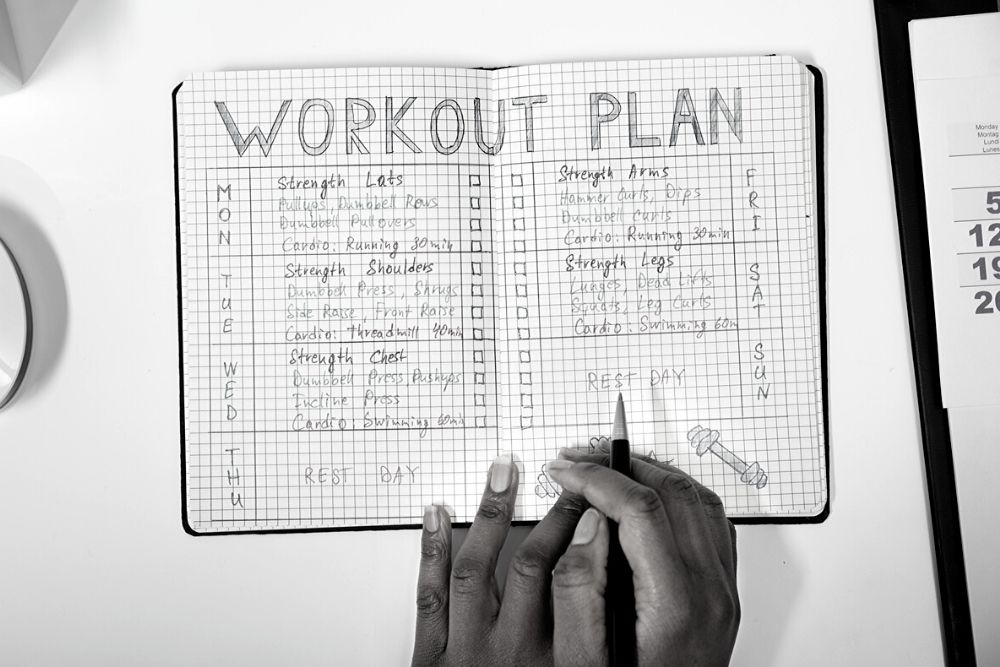Do you ever feel like you’re spinning your wheels when it comes to getting healthy and in shape? You know exactly how out of shape you are but just can’t seem to figure out how to get where you want…or really what exactly you even do want.
This is a far too common scenario for many adults today. They can tell you exactly how many pounds they’ve gained this year, but can’t even begin to tell you how they’re going to lose it. Good thing for you it’s an easy fix, all you need to do is understand a few things about fitness goal setting.
Everyone Has A Problem…
The fitness industry is structured as a problem-solution based system. Think about it, almost everything we encounter is touted as our solution to losing weight, gaining muscle, feeling better, etc. Does any of it ever work? More often then not it doesn’t…but that’s your fault. The fitness industry knows what I said above is true, most adults know exactly where their fitness capabilities are today but are oblivious on how to change it.
Everyone reading this article knows how much their back hurts, how many pant sizes they’ve gone up, and how winded they get going up a flight of stairs. Our daily actions serve as constant reminders of where our current level of fitness is. You can’t avoid it, so most people accept it. These people then seek solutions to these problems and…in comes the fitness industry. The problem is this becomes a cycle; a cycle of buying workout programs, supplements, and gimmicky exercise equipment.
The unfortunate reality is most people never actually achieve their fitness goals. They may get serious about working out or attempt the latest diet, but eventually they go back to their old ways. This inconsistency is the problem. More specifically the lack of a clear goal with no plan for success leads to a loss of motivation. This is why a fitness goal setting strategy is so important.
Fitness Goal Setting: The Strategy
Most people struggle with clearly defining an end goal. They wake up one day and enough is enough, but is it? Odds are this is not the first time they’ve felt this way. They’ve tried a lot of different so called solutions to their fitness woes. Yet come January 1st they find themselves in the same spot they were in the year before. This is because they don’t know how to properly set goals. Instead, they choose to make arbitrary and poorly executed attempts at getting in shape; and no matter how hard they try, they never quite get there. You see, the process to achieving fitness success is actually pretty simple when you break it down, it just takes a little effort.
1) Pick A Specific Goal
This is problem #1 when it comes to fitness goal setting. Most people just don’t know how to properly set a goal. They set these generic aspirations like “I want to lose weight” or “I need to eat healthier” and that’s usually where it stops. A few months later they find themselves in the same place doing the same things.
You have to be specific. Your goals need to be detailed and individual to you.
- If you want to lose weight…How much weight and in what amount of time?
- If you’re looking to gain muscle…How much and what training methods will you use?
- If you want to get in shape…What specifically? Want a better mile time, better figure, healthier joints, etc?
I think you get the point. When you decide what it is you want, the thing you’re going to work for, you have to have an end goal in mind.
2) Know Your Why
At the end of the day, you have to know why you’re doing what you’re doing. It’s the reason you picked the goal in the first place. Knowing your why allows us to be even more specific with your fitness goal setting process. Usually this “why” is something emotional or deeper then just a weight on the scale. We want to tap into this as much as possible during the training process.
You see most people don’t invest in fitness based on logic or reason. Instead, they usually are making the bulk of their decisions based on emotion. It is more than a goal bodyweight or a smaller pant size to most people, and that is ultimately what we are trying figure out. So maybe you want to lose 15 lbs in the next 4 months, that would be a rather specific goal…But why do you? What’s the reason? It could be as simple as I want to look better and there’s nothing wrong with that, but why now? Odds are you’ve been thinking about this goal for months and maybe even given it a few half-hearted attempts. So what’s so special about this moment in time?
It is here where you can find what is motivating you.
- If you want to lose 15 lbs in 4 months…Is it for your daughter’s wedding or a high school reunion?
- Looking to squat 185 lbs for 5 reps…Maybe you want to be stronger to improve your quality of life, your ability to play with your kids, or avoid injury.
- Trying to run a marathon…Is it because you want to set an example for your kids or challenge yourself for the first time in years?
Your actual “why” is going to be individual to you. Use it as a guiding light and motivator towards your success.
3) Get A Plan
So we know exactly where we want to go and why we want to get there, but how do we do it? Now it’s time to plan. We need to reverse engineer the goal, to lose 15 lbs you need to first figure out how to lose 5 lbs. If you are someone with limited fitness experience I recommend starting slow. We want to build healthy habits and to do that we might initially target results that seem easy. The logic behind this is that most people start guns a blazing and soon find themselves missing expectations. This leads to a poor outlook on the goal and eventually quitting the pursuit. To combat this we need to target consistent and attainable progress.
So, instead of starting day 1 with a 5 day per week workout routine and the expectation that you’ll eat healthy for 100% of your weekly meals, we might target something closer to 2 strength training days and a minimum of 1 daily serving of vegetables for your first week. Seems pretty simple right…that’s the point. We want to exceed expectations each week, not barely meet them. Because I know that based on the above example that person will likely find 2 days in the gym to be easy and is probably going to go an extra day. Eating 1 serving of vegetables is likely to actually end up being 2 servings or 1 serving and some fruit.
If they exceed expectations that makes them feel good and keeps them engaged. If they just meet the target for that week, well that’s good too, because they’ve avoided the let down most people face when they miss workouts and eat junk food. From here we can start to build on each week until you’ve not only reached your goal but also developed some healthy habits in the process.
Now Get Started
This should’ve just about covered all the basics when it comes to fitness goal setting. Now it’s up to you to pick a meaningful goal and figure out how to achieve it. Whatever your plan is just make sure you are progressing towards what you want each week. It is important to have a plan in order to keep you on track towards achieving your goal. Check in with your “why” periodically to maintain your focus. Most importantly, give yourself the freedom to fail and make mistakes. This is something new for you and nothing in life progresses and improves linearly. There will be ups and downs, however, if you can stay the course you will get better.
Failing may happen, quitting is not an option.
If you want more information on goal setting check out our recent article on goal setting for athletes. As always, if you have any questions for me feel free to ask them here.
Best,
John Evans

